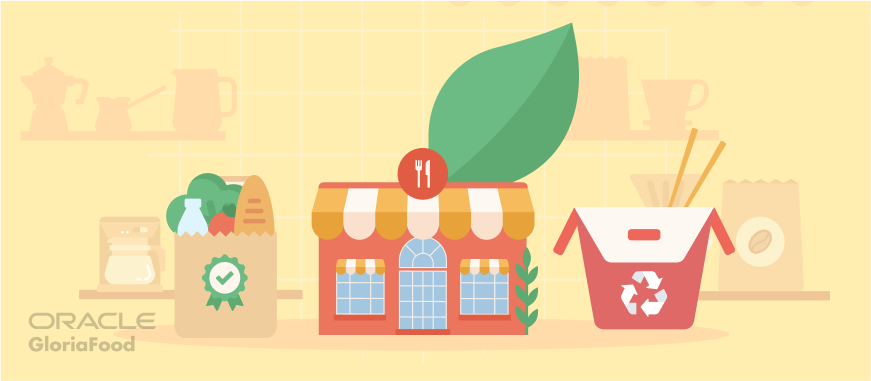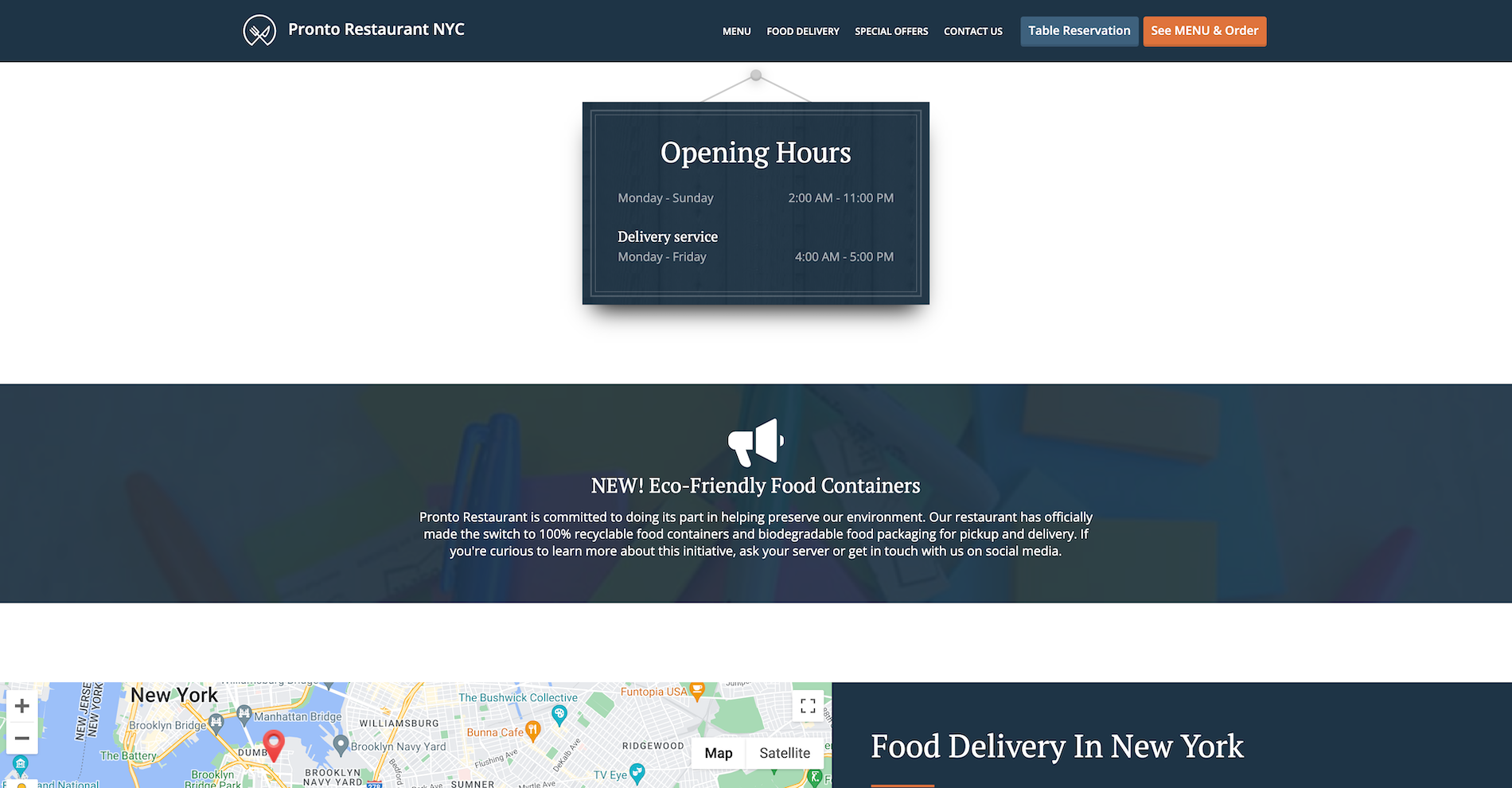- 1.What is Restaurant Sustainability?
- 2.Restaurant Sustainability Trends to Watch in 2022
- 3.10 Restaurant Sustainability Practices to Help You Go Green
- Use sustainable food packaging
- Reduce delivery carbon emissions
- Minimize food waste
- Introduce healthy menu options
- Buy energy-efficient equipment
- Recycle and compost
- Purchase eco-friendly cleaning products
- Reduce water usage
- Use sustainable furniture and consumables
- Do your marketing mostly online
- 4.Wrap up
In our previous post on restaurant sustainability, I talked about making your restaurant more environmentally friendly for your customers. This time, I’ll be talking about in-depth restaurant sustainability practices you can implement as a restaurant owner in your establishment. Let’s get started!
What is Restaurant Sustainability?
Restaurant sustainability is all about food businesses minimizing their impact on the environment by using sustainable packaging, reducing delivery carbon emissions, minimizing food waste, introducing healthy menu options, buying energy-efficient equipment, composting, and more.
Restaurant Sustainability Trends to Watch in 2022
Restaurants and sustainability is a hot topic nowadays, as the world focuses more on how to help and improve the planet. The environmental issues affecting restaurants range from food waste to pollution – and customers have picked up on that.
According to Oracle’s Restaurant Scene 2022 global survey, restaurant sustainability practices heavily influence buying decisions.
Restaurant having biodegradable or recyclable food packaging influences the purchasing decisions of 49% of respondents. Additionally, another 42% find it nice to have.
Delivery is another topic that concerns customers. Low or zero-emission takeout delivery services influence 42% of customers to purchase from a restaurant, while another 46% consider it a nice thing to have.
Restaurants that make efforts to lower food waste influence a whopping 54% of customers to buy from them, while the clear labeling of food sources and ingredients affects the purchasing behavior of 52% of respondents.
Finally, healthy menu options also count for the modern, knowledgeable customer. 70% of survey respondents found healthy choices on a menu important.
Now, let’s take each of these restaurant sustainability practices that customers care about and see how you can implement these and more in your restaurant.
10 Restaurant Sustainability Practices to Help You Go Green
1. Use sustainable food packaging
There are three main types of sustainable food packaging that you can use: biodegradable, recyclable, and reusable.
The most popular one for restaurants is the biodegradable one, which is single-use and will disintegrate in a few days to months. Biodegradable food packaging is usually made of plants or plant waste, and it’s a popular choice in the food and beverage industry, especially for items like salads, wraps, or even vegan chocolate treats.
Recyclable packaging is also single-use, but instead of disintegrating, you send it away to a recycling center, where it gets turned into a new product. If you use recyclable packaging, install recycling bins in your restaurant to make it easier for customers and staff to dispose of trash.
Finally, reusable packaging is, as the name suggests, something that you can keep on using for years. Because it needs to be durable, it’s most often made of glass, wood, aluminum, bamboo, or even recycled plastic.
While the latter is not an option for food delivery, you can encourage customers to bring their own food or drink containers to help save the planet. Some restaurants even offer small discounts for people who bring their own to motivate them to make a habit out of it.
Once you make the switch to sustainable food packaging, you should let everyone know by posting about it on your website, social media, and in email newsletters. By getting a sales-optimized website from us, you can easily add an announcement section anywhere on your homepage. Customize the text however you want to let visitors know about your eco-friendly initiatives. Here is an example of how it could look:
2. Reduce delivery carbon emissions
Many things contribute to a restaurant’s carbon footprint. Still, food delivery is one of the biggest offenders, especially with the recent rise in delivery orders due to the pandemic. Here are four things that you can do right now to reduce the carbon emissions of your food delivery service:
- Optimize the delivery route for your drivers by establishing order priority, identifying traffic bottlenecks, and assigning areas to drivers.
- Have drivers deliver multiple orders at a time to increase efficiency.
- Invest in electric scooters or cars for your drivers.
- Don’t provide disposable utensils unless specifically requested.
3. Minimize food waste
Next, let’s see how to improve food sustainability by minimizing restaurant food waste. The best and easiest way to reduce food waste is to monitor expiration dates of perishable items and use them first using the FIFO (first-in, first-out) method.
Consider using restaurant inventory management software to keep track of produce more efficiently. And when food waste starts to become inevitable, and you know you can’t use all the ingredients before they go bad, donate that surplus to local shelters.
Read more: 7 Effective Restaurant Inventory Management Tips for 2022
To avoid food waste even further, consider shrinking your portions if you notice most customers leave a lot of food on their plates.
4. Introduce healthy menu options
We mostly think of energy or food waste when we contemplate restaurant sustainability. But how can sustainability be improved without considering your actual menu too? In an article published in the MDPI journal, researchers discovered that the leading restaurant sustainability practices implemented by chain restaurants are:
- Presenting nutrition-related information
- Providing healthy menu options
- Using organic or natural produce
Why is food sustainability important? Because we are what we eat. Introducing healthy menu options isn’t just a way to attract people with various diets but also lower your carbon footprint.
Implement these practices to make your menu healthier:
- Add healthy alternatives to popular menu items (like vegan burgers or vegetarian pizza)
- Buy your ingredients locally and use them seasonally (Read more: The Benefits of a Seasonal Restaurant Menu & How to Implement One)
- Clearly label the ingredients in every meal as well as their source where possible
- Include more whole foods and less processed foods in your menu
- Replace potatoes with sweet potatoes and healthier side dishes
- Include legumes and nuts in your menu
- Use plant oils for cooking
- Focus on good fats
- Serve seafood dishes
- Provide dairy replacements
- Reduce the use of added sugar
5. Buy energy-efficient equipment
Small restaurant sustainability is also about energy-efficient appliances and equipment. They are more expensive initially, especially for small businesses, but they consume less. They also help you reduce energy consumption in the long run.
When you have to replace appliances, consider purchasing them second-hand. You will find plenty of restaurant equipment that was barely used but is still considerably less expensive than a brand-new one.
If you want to make sure you’re buying energy-efficient appliances, check whether they have the Energy Star logo. This is proof that they use less energy but still perform excellently.
6. Recycle and compost
Recycling is one of the most popular and widespread ways of being more environmentally conscious. Whether you are recycling things yourself or sorting your waste and sending it to be recycled, you are still making a difference.
Not to mention recycling increases efficiency, decreases energy consumption, and actually saves you money. Learn how to recycle glass bottles, wooden crates, cardboard boxes, and any other materials you’re using in your day-to-day operations.
Composting is another restaurant sustainability practice you can use. Create a composting barrel where you dump all your food waste and then use that to feed the soil. It may sound complicated for a beginner, but it’s really not. Read this guide on how to make compost to learn more.
7. Purchase eco-friendly cleaning products
If you own a sustainable cafe or restaurant, you probably know better than to use cleaning products that damage the environment. Most eco-friendly cleaning products are indeed pricier than regular ones. Still, you can find some gems if you look closely enough.
First, you need to understand that regular cleaning products contain harsh and harmful chemicals that pollute the water and air. On the other end, environmentally friendly cleaning products are free of chemicals, and they’re also better for your health.
But how can you know a cleaning product is eco-friendly? Look for labels like Greenguard, Green Seal, Design for the Environment, Chlorine Free Products Association, or Environmental Choice Program.
8. Reduce water usage
Water conservation is another pillar of the sustainable restaurant concept and something you should pay attention to carefully. Even a leaky faucet can cause you to lose a ton of money in the long run.
Here are some tricks you can use to reduce the amount of water you consume:
- Wait and run the dishwasher when it’s full;
- Use water-saving toilets;
- Install low-flow faucets or motion-sensor taps;
- Replace bottled water with a filtration system;
- Only bring water to customers who specifically request it;
- Use solar panels for water heating;
- Capture rainwater for your garden.
9. Use sustainable furniture and consumables
The way you furnish and decorate your restaurant can also impact the environment. Look for local furniture makers that use sustainable, recycled materials. If you’re crafty, talk to site contractors to help you scout commercial building sites for materials you can repurpose.
You might also like: 15 Restaurant Design Tips That Will Attract More Customers
Use zero-VOC (volatile organic compounds) paints when painting your walls or furniture. They are a healthier and more environmentally-conscious alternative to regular paint, which is full of chemicals. These chemicals release in the air and can induce headaches, central nervous system issues, and respiratory and skin irritation.
Another thing you can do is use eco-friendly consumables such as LED light bulbs. Consider installing motion sensor light fixtures in the bathroom to consume less energy.
10. Do your marketing mostly online
Advertising your restaurant should also be an environmentally-friendly effort. First of all, most marketing has moved online already, so that’s where you need to be focusing your efforts too. Second, there are ways to advertise your restaurant offline too without wasting paper or contributing to waste and pollution.
Read more: 12 Online Marketing Strategies for Restaurants
Use new paper materials instead of classic paper for your flyers. These materials require fewer trees, which are replaced with wheat, hemp, cotton, or grass. Also, be mindful of where you distribute flyers so as not to be wasteful. Research your target audience and leave flyers where you know people are interested and won’t immediately throw them in the trash.
You can use our delivery heatmaps to pinpoint the order density in the zones you’re targeting.
That’s where most of your customers are, so you know that a flyer with a special discount will work wonders there.
Wrap up
The restaurant sustainability practices above are designed to help you take action ASAP and start running a more environmentally-friendly business. While they may seem overwhelming to implement all at once, you can take them one step at a time. Remember that even a small step taken towards a more sustainable restaurant can make a difference.


